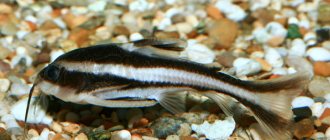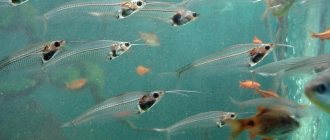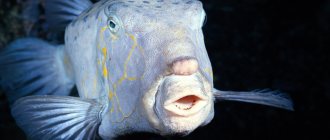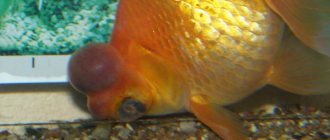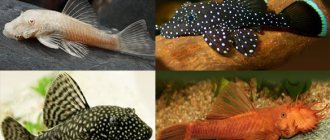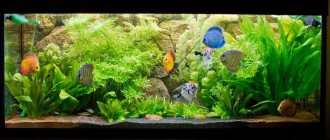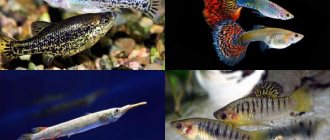Many experienced aquarists and those who keep fish at home for the first time pay attention to such a species as characin aquarium fish. Characin fish have a very bright color or unusual shape, so they look beautiful in the aquarium. Professionals breed fish for sale, and amateurs breed fish for aesthetic pleasure.
A characteristic feature of the characin family is the dorsal adipose fin, which is located closer to the tail. The fish gained popularity due to its mobility and beautiful color. The species originates from Africa and South America. Among the characins there are both predators and herbivores. The lifespan of fish usually does not exceed 3-5 years. They reach sexual maturity between 6 and 12 months. Fish of this species like to live in schools (with the exception of predators). Therefore, it is better to get 10-15 fish at once.
Maintenance and nutrition
Keeping characin fish is simple; you don’t have to change the water for a long time. The main thing is not to overfeed the fish. Simple conditions such as:
- Soft, slightly acidic water.
- Aquarium 30-40 liters.
- Bright light.
- The water temperature should be from 20 to 28 degrees.
- Dense vegetation.
- Feed.
The fish are not picky about food. Depending on the species, they can eat live and dry food. Feed can and should be alternated. Feeding fish only dry food is not recommended due to the structure of the intestines; a monotonous diet can lead to death. Live food includes:
- bloodworm,
- Artemia,
- basket,
- Cyclops,
- daphnia.
Food should be given in small portions so that it does not fall to the bottom of the aquarium. Each type of fish has its own food. Some fish of the family can eat vegetation that is in the aquarium.
general information
In their natural environment, fish from this family live in the waters of Africa and are also found in South and Central America. They prefer stagnant bodies of water or with a weak current, where there is soft, old water, a lot of plants, and a muddy or sandy bottom.
The Characin family, or charax, is a large, to say the least, freshwater ray-finned fish family, consisting of a dozen subfamilies, 165 genera and 1,200 species. Basically, these are small, peace-loving schooling fish, neighboring in the ecological niche with cyprinids.
They are often mistaken for small piranhas because of their body shape and their habit of eating fallen food in the aquarium - live, dry or frozen. The similarity cannot be called accidental, because the families of both characins and piranhas belong to the same order - characins.
Aquarists have been familiar with characin fish for a long time, and they, in turn, have gained wide popularity due to their visual appeal, unpretentiousness and low maintenance requirements. Some varieties are so hardy that they are suitable as the first fish for a novice aquarist.
Representatives of the family are quite diverse: both in color and size. However, there are some similarities that allow them to be classified as one family:
- high body , compressed at the sides;
- eyes of decent size;
- muzzle with snout turned up;
- expanded anal fin ;
- presence of a small adipose fin .
In an aquarium, these fish usually “stand”, maintaining this position thanks to small jerks. Ichthyologists believe that the adipose fin is a vestigial part, and was previously a developed second dorsal fin.
Types of characin fish
There are approximately 1,200 species of fish. The most popular fish among aquarists is the tetra. These waterfowl are very easy to care for.
At home they prefer to live in packs. The males are the most beautiful, the females are more modest in color. Tetras are unpretentious in their diet and are easily adaptable. Tetra fish food includes a whole series of dry food for different species. The color of the fish is different. There are many subspecies of tetras.
Royal or imperial tetra
Small individuals up to 4 cm in length. They attract breeders due to their original color and ease of reproduction at home. Gets along with many species and is unpretentious in food: live, dry and frozen food.
Popular members of the family
Many fish from this large family are loved by aquarists all over the world. Some are quite rare, while others cannot be found in any decent pet store. It is often these “charats” that are recommended to be kept as the first aquarium inhabitants.
Neons
Few aquarium fish can boast the same popularity as these bright, small, unpretentious “charats”. Their main advantages include fertility, low price and ease of maintenance and breeding.
It is also recommended to start Neons in a set - a flock is the most impressive and interesting to observe. But in order for the fish to build and maintain the correct school, they need a spacious tank. They were nicknamed neons due to their bright markings, similar in color to neon signs.
Unfortunately, the intelligence of these inhabitants is not very highly developed, so they often get into trouble. They can penetrate the smallest holes, but are unable to get out, which is why they die. When decorating an aquarium, these nuances should be taken into account.
There are 4 types of neons: blue, black, red and green. Despite their similar appearance, there are still a number of significant differences between them, including the susceptibility of various infections.
Blue neon (neon tetra)
The species was discovered in the 30s of the last century, and almost immediately its representatives won the love of aquarists. Then many were ready to part with a tidy sum in order to become the owners of a flock of beautiful blue fish. These fish were considered valuable, and not everyone could afford their price. After all, at that time, breeders were unable to breed offspring of blue neons in captivity, and all imported specimens were caught from natural bodies of water.
In the process of trying to breed, breeders realized what their main mistake was. As it turned out, even if neons could live in hard water, then for spawning they required water of increased softness - up to 3°dH. When we managed to start breeding blue neons, their price dropped sharply. They are still the cheapest aquarium fish.
Appearance of individuals:
- body length does not exceed 3 cm;
- the back is a light olive shade;
- A bright blue stripe runs along the entire body - from the eye to the adipose fin;
- the caudal fin is partially reddish in color.
Red neon (tetra cardinal)
Two decades later, zoologists managed to discover another type of neon. But, unlike blue neon, red fish have not aroused such intense interest from aquarists. The red neon has a more intense color. The red color, starting from the edge of the eye, spreads to the entire body. In addition, the body of these fish is wider and more flattened than that of their blue counterparts.
An interesting fact is that red neons have never been diagnosed with the so-called neon disease, or plistophorosis. Although neons often suffer from this disease caused by microsporidia - protozoa that reproduce like mushrooms, spores.
Black neon (black neon tetra)
It is particularly attractive and spectacular in appearance, but only if the neon receives good nutrition and care, and the aquarium is equipped with proper lighting. Like other neon colors, the black one has a longitudinal luminous stripe on its body, only it is of a silvery hue. Below it (from the eyes) the body of the fish is covered with black scales of a blurry tone.
Green neon
He is also a green neon tetra or costello. This small fish, whose size does not exceed 2.5 cm, has a green, olive-colored body. There is a stripe of light green color along the body, and there is a noticeable black spot near the base of the tail. There are no special recommendations for the content of neons; they are unpretentious and very tenacious.
Erythrosonus
Domestic aquarists dubbed this characin fish the firefly tetra, but the somewhat outdated Russian name is gracilis. The size of erythrozonus living in aquariums is 3-4 cm. They have a translucent, light yellowish back, and from the eyes to the base of the tail there is a stripe glowing with orange neon. The first rays on the dorsal fin are red.
Ternetia
Another popular member of the family, hardy, unpretentious and easy-going. The length of the thorn reaches 5.5-6 cm. The body of the fish is high, flattened on the sides, and due to the expanded anal fin it looks rounded. The scales are silvery, sparkling in the light of the lamps, making these inhabitants look like shiny new coins.
The ternation also has one more decoration - an anal fin-skirt, in a contrasting black tone. Its main color is light gray. The front part of the body is marked by two vertical black stripes. Many breeders became interested in thorns, and fish with even more interesting and unusual colors were born:
- black tetra - it is also called the “black widow” or the “black skirt” tetra;
- golden (xantharine);
- white (albino) - among aquarists it was nicknamed “white skirt”.
Also during the selection process, thornets, which have luxurious long veil fins, saw the light. Unfortunately, these beauties often suffer from experimenters who artificially color aquarium inhabitants. As a rule, in unnaturally bright fish, they are also called “caramels,” the paint is washed out over time. But this is not the worst thing - dyes weaken the immune system of individuals, and “caramels” do not live long.
Geneticists did not stand aside either: they managed to modify the thorn, obtaining brightly colored individuals - GloFish. Their coloring is not temporary; it is passed along with a set of other hereditary characteristics from parents to children. Such specimens have a unique property - their body glows under UV rays and blue spectrum lamps. You can find yellow, green, orange, blue, pink and lilac fluorescent fish on sale. Glofish do not require special care or maintenance.
Ornathus
Peaceful, hardy and common aquarium fish, which can often be found in pet stores. They have a body of a typical “characin” shape. There are several varieties of ornathus, similar in content, character and reproduction.
Ordinary
As for the natural color of these fish, it is brownish-bronze, the fins have white tips. A dark stripe runs vertically from the gill covers on both sides.
But today it is not easy to acquire a common Ornatus with this mark, since the offspring obtained from crossing fish with Ornatus of other species do not have these stripes. Breeders managed to develop various forms of ordinary ornathus: white-finned, pink, veiled.
Black Ornathus
Another name for the species is black phantom. This fish has a very impressive coloration, because its dark fins contrast favorably with the gray scales of the body.
Red Ornathus
She was also nicknamed the phantom, only red. This inhabitant is more demanding of living conditions and loves cool water. Against the background of the translucent body, the bright ruby fins of the fish look very attractive.
Glass tetra
One of the most unusual characin fish. The average size of a glass tetra is about 6 cm. It has a slender, elongated and transparent body. The skin is also transparent, and the internal organs and spine are clearly visible through them. The tetra's body is pale blue or bluish-gray. Her head is small, and her eyes are disproportionately large. The ventral, anal and lateral fins are transparent. The dorsal fin is yellowish in color, and the caudal fin is bright red.
At the age of 5 to 7 months, the fish reach sexual maturity. Like most small characins, female adult glass tetras are significantly fuller in the abdomen, especially during spawning.
Neons
This is not only the most famous species in the family, but also one of the most common aquarium fish. Neons are prolific and easy to breed, so the cost of these tiny fish is usually low. They look most impressive in the company of representatives of the same species. In spacious aquariums where neons live in flocks, their luminous stripes attract attention. It is from these markings, which resemble burning neon, that they get their name.
There are 4 types of these characin fish: red, black, green and the most common - blue. They are very similar in appearance, although there are significant differences, including susceptibility to different diseases.
Reproduction
The characin family is characterized by rather difficult breeding, which is associated with the seasonality of their reproduction, the need to maintain a special temperature regime, the importance of specially prepared water, etc.
In addition, this type of fish often eats fry and eggs, which is why it is necessary to create separate conditions for them.
At the same time, many professionals and experienced amateurs easily cope with this process; for this they use a special aquarium for spawning, equip it with a net, an aerator, a thermostat and a small number of plants.
Golden wedge belly (platinum)
These fish are distinguished from many other species by their unusual body shape. Combined with simple maintenance, this makes the wedge belly an excellent choice for beginner aquarists. This is, without a doubt, one of the most common species among hatchetfish. The fish is widespread in all major river systems: Orinoco, Parana, Amazon and others. Prefers mainly stagnant waters - swamps, floodplain lakes, quiet creeks. They most often live in areas with an abundance of surface aquatic vegetation.
Adults reach a length of 7 cm. Wedge-bellies have a wedge-shaped body, laterally compressed. It resembles an ax blade. The back is yellow with golden hues, the belly is silvery. Stripes that appear blue at a certain angle of light flux may appear.
Compatibility
It is not difficult to find neighbors for peaceful varieties of Characin fish. They get along well with the following types of underwater inhabitants:
- zebrafish;
- small barbs;
- mollies;
- swordtails;
- guppy;
- platies;
- scalars;
- apistograms;
- snails;
- shrimp.
You should be careful when adding fish with veil-like fin plumage to the Kharakas species; these pets can nip it thoroughly.
You should not combine Charats with aggressive predators - cichlids, piranhas, Koi carps.
Lemon tetra
This yellow beauty is especially spectacular in large flocks. Lemon color, the intensity of which depends on the intensity of the consecration, predominates in its color. The brightest parts of the fish are the black and yellow anal and dorsal fins. Under natural conditions, in times of danger, lemon tetras gather in huge flocks. Their bright fins confuse a potential predator.
Ternetia
A very peaceful and hardy fish, which has an average size for the family - about 6 cm. Its body is high, slightly flattened on the sides, and because of the wide anal fin it appears round. In reflected light, the silvery scales sparkle, giving the fish the appearance of a coin.
The most striking part of the thorn is the black anal fin, which resembles a skirt. The background color of the thorn is light gray. Two black vertical stripes are clearly visible in the front of the body.

